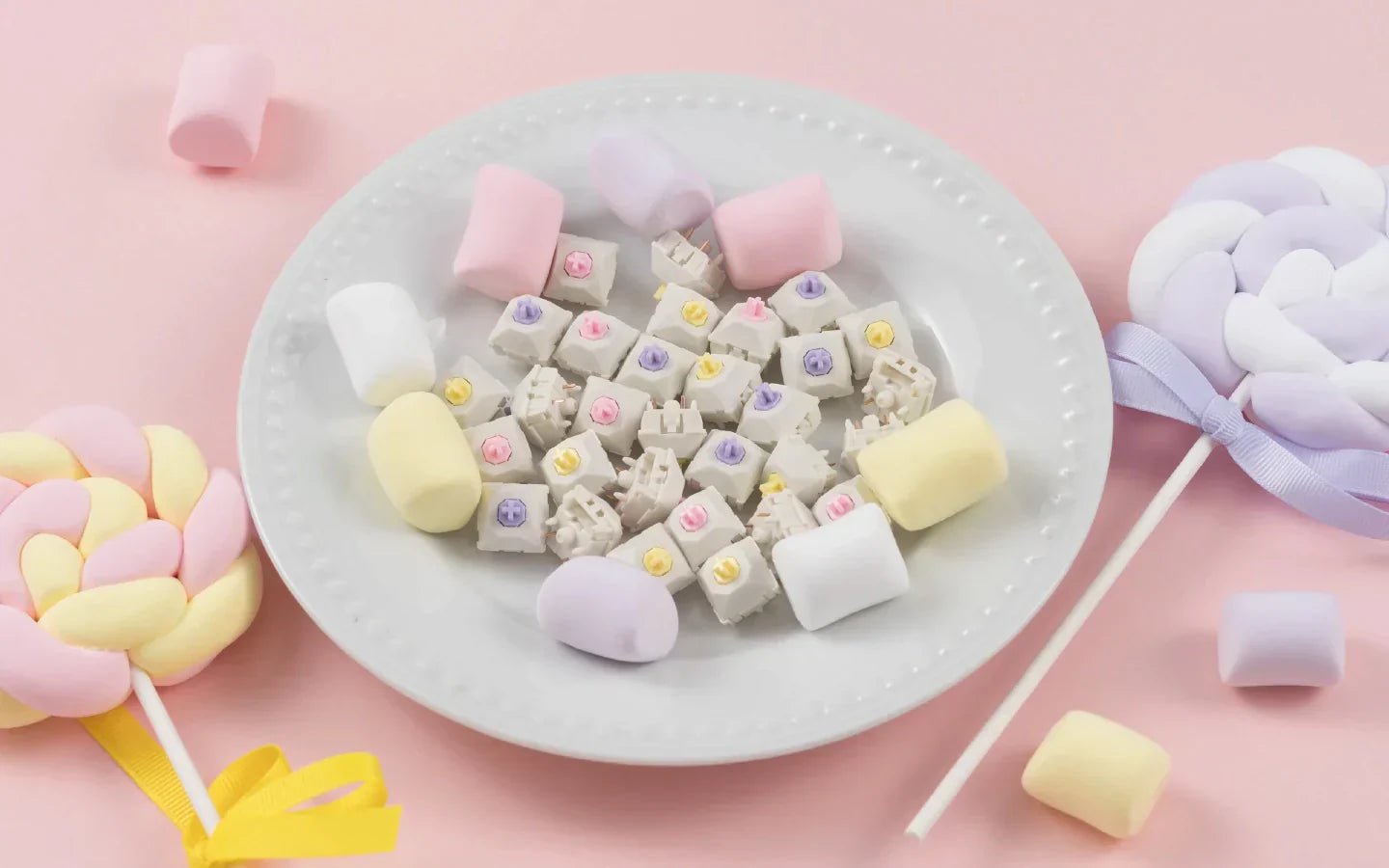Switch materials 101 — how housings and stems shape your sound
When you browse switch specs at KeyBay Tech, you’ll see terms like PC, PA66, POM, UPE, or POK. These are actual plastics and blends that influence how your board sounds and feels.
This guide breaks down the major materials used in switch housings and stems, what each does acoustically, and how to choose based on the kind of sound you want—clack, thock, or something in between.
Why switch materials matter
A switch isn’t just a spring and a slider. Its top housing, bottom housing, and stem are molded from specific plastics that differ in density, friction, and resonance. Those variations shape how sharp or muted the bottom-out is, how smooth the travel feels, and even how much stem wobble you get.
Common housing materials
Polycarbonate (PC)
Used for transparent or translucent housings. PC produces a crisper, higher-pitched sound and a snappier top-out. It’s often chosen for RGB builds or “clacky” sound profiles.
(Examples: Bsun Frost Tile, TTC KOM HE RGB)
Nylon (PA66 / PA12)
The most common opaque housing plastic. Nylon is slightly softer than PC, which results in a deeper, rounder “thock”. PA12 tends to be even more muted and smooth than PA66.
(Examples: HMX Sprite, Keygeek Guns & Roses, Blue Cheese V2)
UHMWPE / UPE (Ultra-High-Molecular-Weight Polyethylene)
Less rigid than nylon or PC but extremely smooth. Its low friction coefficient gives softer top-out and very quiet travel. Used selectively in both housings and stems.
POK (Polyketone)
An emerging polymer used by Keygeek and others. Positioned between POM and UPE—smooth and stable, slightly muted. More dimensionally consistent than pure UPE, but less bright than PC.
HPE (reinforced UHMWPE-type blends)
A newer class of UPE-derived plastics made to solve molding issues of pure UHMWPE.
Typically marketed as deeper-sounding, more controllable variants.
PBT / fiberglass-reinforced nylon (PA66 + GF / PBT + GF)
Less common but still listed on Keygeek specs. The added glass fibers stiffen the polymer, which can raise pitch and reduce flex, producing a sharp but contained clack.
Common stem materials
POM (Polyoxymethylene)
The industry standard. It’s naturally lubricious and gives smooth, consistent travel.
Because it’s dense, it adds a neutral-to-slightly-bright sound.
(Seen in HMX Sprite, Guns & Roses, many KeyBay linears.)
UPE / UHMWPE
Ultra-smooth, self-lubricating material. Produces buttery glide and softer landings, slightly reducing noise compared to POM.
POK
Used in some Keygeek designs. Offers a stable glide with slightly more structure than UPE—often sitting between UPE’s softness and POM’s firmness.
LY / L4 blends
Proprietary UHMWPE-family mixes (not standardized). Reported to give a very smooth glide while maintaining stability.
(Seen in Bsun Frost Tile and Blue Cheese V2.)
Matching materials to sound & feel
|
Housing |
Stem |
Expected sound |
Feel |
Example |
|
PC |
POM |
Bright, crisp “clack” |
Firm |
Cheese V2 |
|
PA12 |
POM |
Lower-pitched “thock” |
Smooth |
HMX Sprite |
|
PA66 |
POM |
Mid-tone, solid |
Controlled |
Guns & Roses |
|
PA12 |
UPE |
Rounded “marbly” thock |
Buttery |
Starwish |
|
PC |
UHMWPE |
Bright but smoother |
Soft clack |
TTC KOM RGB |
Real-world listing example
Let’s take one you can find right now at KeyBay Tech — Starwish Linear Switch:
-
Top housing: PA12 (nylon)
-
Bottom housing: PA12 (nylon)
-
Stem: UPE (enhanced)
Because PA12 is softer than PC and UPE stems reduce friction, this combination tends to dampen higher frequencies, resulting in a rounded, low-pitched “thock” rather than a sharp clack. In practice, Starwish switches sound deep and feel extremely smooth—ideal for foamless builds that already lean brighter.
How to hear and feel the difference yourself
Every polymer interacts differently with your plate, foam, and keycap materials. Two builds using the same switches can sound radically different depending on case cavity and dampening.
If you’re shopping online, most our switches can be found on youtube with various content creators doing detailed sound tests. Here’s one from MikeyTypes with the Keygeek Starwish we discussed earlier. .
If you’re in the GTA, you can try many of these switches in person at our Scarborough shop. We keep demo boards on the counter so you can A/B test nylon vs PC housings, or POM vs UPE stems, before committing to a full set: 4675 Steeles Ave E, Unit 2B19.
We’re open Tuesday–Sunday for pickup and hands-on testing.
Shop switches → https://keybay.tech/collections/switch
Author: Navid



Share:
Keyboard Switches Guide: Linear vs Tactile – Which One Is Right for You?